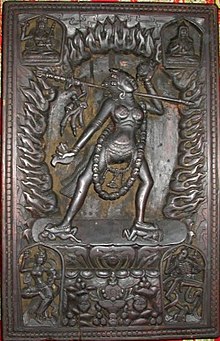Vajrayogini
Vajrayogini ( Sanskrit वज्रयोगिनी Vajrayoginī ; also Dorjé Neljorma , Tibetan རྡོ་ རྗེ་ རྣལ་ འབྱོར་ པ ། Wylie rdo rje rnal 'byor ma ) is a tantric spirit being (a Dakini ) and one of the main initiation goddesses of Vajrayana , one in India from the compound Mahayana Buddhism movement that originated with Hindu tantra.
According to the system of Gelug and some Kagyu masters, Vajrayoginī tantra belongs to the mother tantras (Tib .: ma-rgyud).
Vajrayoginī is also a personal protection and meditation deity, yidam (Sanskrit: ishtadevatâ).
tradition
India
Vajrayoginī and Vajravārāhī in Sādhanamālā (edition of Bhattacharyya, 1925–1928) cite about twelve complete sadhanas (instructions for pictorial meditation), in Guhyasamayasādhanamālā more than fifty of these iconographic descriptions, in which one can distinguish around twenty different forms of deity.
Chinnamasta , a female deity of the Shaiva tradition in the group of ten Mahavidyamahāviyās , has outgrown this Buddhist model (Trikāyavajrayoginī); the first evidence of their veneration dates back to the fifteenth century.
Tibet
The Tantra to vajrayogini was within the traditions of the New translations for the first time of Drogmi Lotsawa, the great translator and forefather Sakya -Schule translated into Tibetan and introduced in the eleventh century in Tibet. Therefore, the practice of Vajrayogini is a focus in the Sakya school. In the Tibetan collections Kanjur and Tanjur (Bka '' gyur, Bstan 'gyur) there are about 45 sâdhanas with Vajrayoginī or Vajravārāhī in the title. Vajravārāhī, a special form of Vajrayoginī, on the other hand, has great weight in the Kagyu school. The vision of his disciple Naropa is well known , to whom Vajrayoginî appeared as an ugly, old woman who asked him to give up monastery and scholasticism in favor of yogic practice.
The form of Vajrayoginīs associated with Nāropa is called Narodakini (Nāros tradition of the dākinī) or Nārokhecarī (Nāros heaven-goer).
Another form of the Vajrayoginī is Troma Nakmo .
In the Nyingma school the tradition goes back to Padmasambhava , 8th century AD.
presentation
Identical characteristics of all forms of Vajrayoginī: she is naked, in the prime of her youth, two-legged, has a head that is not adorned by a Buddha in the crown, three eyes. Most of its forms are red (saffron red, vermilion , bright red) and two-armed, in the left hand it carries a skull bowl (Sanskrit: kapāla). In her right hand she can hold a vajra or a cleaver (Sanskrit: kartri, kartrikā). In the bend of the left arm is a staff adorned at its upper end with one or three skulls and a double vajra (Sanskrit: khatvānga). Her body is adorned, among other things, with a chain made of skulls.
The color composition is - with the exception of Troma Nakmo - mainly red and white.
It may be shown in the dance posture (Sanskrit: ardhaparyanka-āsana), in which one leg is drawn to the body, or in the ālīdha posture, which is similar to the one when drawing a bow.
Vajrayoginī also appears as prajnā ( shakti , companion) of heruka, both are then in yab-yum . Their forms and those of Vajravārāhī sometimes mix iconographically.
symbolism
The staff symbolizes the means that lead to liberation; the cleaver, cutting through neurotic tendencies; the skull cup transcendent wisdom (Sanskrit: prajñā ); the combed hair the passionate anger; the crown of five skulls on her head, the five Buddha families and their wisdom; the three eyes the knowledge of the past, present and future; the chain with the fresh skulls, the 51 samskāras, which are purified in non-thinking; your other jewelry like bracelets u. s. w. the six perfections (Sanskrit: pāramitā, giving, morality, patience, effort, concentration, wisdom); her two arms the unity of wisdom and means (Sanskrit: prajñâ , upâya); the corpse on which she stands, the death of ego-centeredness.
present
Nirmanakaya dakinis are not only recognized as embodiments of historical personalities, masters who are considered dakini embodiment also live today, including
- Khandro Rinpoche , a master of the Kagyu and Nyingma schools, daughter of the Mindrolling Tichen . She was recognized by the 16th Karmapa as the reincarnation of the Great Dakini of Tsurphu , Khandro Ugyen Tsomo.
- Jetsun Kushog Chimey Luding Dölkar , a master of the Sakya school, who is considered to be the embodiment of Prajnaparamitas , Taras and Vajrayoginīs.
literature
- Elizabeth English: Vajrayoginī. Her Visualizations, Rituals, and Forms. A Study of the Cult of Vajrayoginī in India . Wisdom Publications, Boston 2001, ISBN 0-86171-329-X .
- Chögyam Trungpa: The Vajrayoginī Shrine and Practice . In: Deborah E. Klimburg-Salter: The Silk Route and The Diamond Path. Esoteric Buddhist Art on the Trans-Himalayan Trade Routes . University of California, Los Angeles 1982.
- Adelheid Herrmann-Pfandt: Dākinīs. On the position and symbolism of the feminine in tantric Buddhism . 2nd, expanded edition. Indica et Tibetica Verlag, Marburg 2001, ISBN 3-923776-20-9 .
- Kelsang Gyatso: Guide to Dakini Land - The Practice of Supreme Yoga Tantra by Buddha Vajrayogini . Tharpa-Verlag, Zurich, Berlin 2005, ISBN 3-908543-23-1 .
credentials
- ↑ Binding Practices in Mother Tantra Study Buddhism
- ^ Buddhist Leaders, et al. a. Brief information about Khandro Rinpoche ( Memento of the original from May 6, 2008 in the Internet Archive ) Info: The archive link was inserted automatically and has not yet been checked. Please check the original and archive link according to the instructions and then remove this notice.
- ↑ Brief information about Her Eminence Jetsun Kushok Chimey Luding at the bottom of the page


